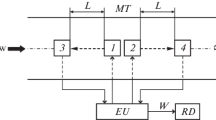Abstract
The causes of noise in electromagnetic flowmeters are reviewed, and some examples given of the equivalent thermal noise resistance likely to be found in practical flowmeters. Signal-to-noise ratio is examined in relation to both the unwanted transformer e.m.f.s and the type of magnet excitation used. It is shown that a sinusoidally excited flowmeter can have an effective noise bandwidth no greater than the output bandwidth, while flowmeters using complex exciting waveforms are, because of practical limitations, likely to have noise bandwidths several times this amount if large reduction of transformer e.m.f.s is to be achieved. In particular, a combination of complex exciting wave and peak detection can lead to greatly excessive noise, especially when half-wave detection is used. The best conditions for low noise and high rejection of transformer e.m.f.s when using complex waves are mean full-wave detection and squarewave excitation. Amplifier flicker noise is probably more important with complex wave flowmeters than with sinewave ones, for technical reasons. A description is given of the experimental measurement of effective noise bandwidth with different detectors, and of the corrections which had to be applied. The optimum output bandwidth is discussed in relation to the blood flow pulse.
Sommaire
Les causes du bruit dans les débitmètres électromagnétiques sont passées en revue et quelques exemples donnés de la résistance équivalente de bruit trouvée dans les débitmètres utilisés en pratique. Le rapport signal/bruit est étudié d'après les effets dûs au signal parasite indésirable du transformateur et suivant le type d'excitation magnétique employée. Il est démontré qu'un débitmètre excité sinusoidalement peut avoir une bande passante de bruit inférieure à la bande passante du signal de sortie, tandis que les débitmètres utilisant des signaux d'excitation complèxes sont, à cause des limitations pratiques, sûrs d'avoir une bande passante de plusieurs fois supérieure à la précédente. En particulier, la combinaison d'une onde excitatrice complèxe et d'une détection crête peut mener à un bruit trop important, spécialement quand on utilise la détection mono-alternance. Les meilleures conditions pour obtenir un niveau de bruit faible et une réjection importante du signal parasite du transformateur, lorsque l'on utilise des ondes complèxes, sont essentiellement une détection bialternance et une excitation par signaux carrés. Le bruit de fond de l'amplificateur est plus important avec des débitmètres utilisant des signaux complèxes que des signaux sinusoidaux. On donne une description de la mesure expérimentale de la bande passante effective dûe au bruit en utilisant différents détecteurs et les corrections que doivent être employées. La bande passante optimale du signal de sortie est discutée d'après la valeur du débit sanguin.
Zusammenfassung
Die Ursachen des Rauschens in elektromagnetischen Strömungsmeßgeräten werden zusammengetragen. Einige Beispiele des äquivalenten thermischen Rauschwiderstands, der wahrscheinlich in praktischen Strömungsmeßgeräten auftritt, werden gegeben. Das Signal/Rausch-Verhältnis wird untersucht auf seine Beziehung zu unerwünschten Transformatorfeldstärken und zum Typ der magnetischen Anregung. Es wird gezeigt, daß ein sinusförmig angeregtes Strömungsmeßgerät keine größere effektive Rauschbandbreite haben kann als die Bandbreite am Ausgang, während Geräte, die komplexe Wellenformen zur Exzitation verwenden, wegen praktischer Beschränkungen mehrfach größere Rauschbandbreiten haben können, falls eine starke Verminderung der Transformatorfeldstärke erreicht werden soll. Die Kombination einer komplexen Exzitationswelle mit einem Impuls detektor kann zusätzliches Rauschen hervorrufen, besonders wenn ein Halbwellendetektor verwendet wird. Die besten Bedingungen für niedriges Rauschen und starke Unterdrückung der Transformatorfeldstärke bei Benutzung von komplexen Wellen sind mittlere Ganzwellendetektion und quadratische Wellenexzitation. Das Flackerrauschen des Verstärkers ist bei komplexen Strömungsmeßgeräten aus technischen Gründen wahrscheinlich stärker als bei Geräten mit sinusförmiger Exzitation. Die experimentelle Messung der effektiven Bandbreite mit verschiedenen Detektoren sowie notwendige Korrekturen werden beschrieben. Die Beziehung der optimalen Ausgangsbandbreite zum Blutströmungspuls wird diskutiert.
Similar content being viewed by others
References
Elliott S. E., Hoffman, J. I. E. andGuz, A. (1963)Med. Electro. Biol. Engng.,1, 323.
Ferguson, D. J. andWells, H. S. (1959)Circulation Res.,7, 336.
Fink, G. F. (1947)Radar Engineering, pp. 127, 508. McGraw-Hill, New York.
Giori, F. A. (1960)I.R.E. Trans. Med. Electron.,7, 211.
King, L. V. (1936)Phil. Mag.,13, 129.
Kolin, A. (1941)Rev. Sci. Instrumn.,12, 555.
Kolin, A. (1960)Medical Physics III, p. 141, Year Book Publishers, Chicago.
Kolin, A., Spencer, M. P. andDenison, A. B. (1959)I.R.E. Trans. Med. Electron.,6, 220.
Robinson, F. N. H. (1964)Noise in Electrical Circuits pp. 53, 27. Oxford University Press.
Shercliff, J. A. (1962)The Theory of Electromagnetic Flow Measurement. Cambridge University Press.
Shirer, H. W., Shackelford, R. B. andJochim K. E. (1959)Proc. I.R.E. 47, 1901.
Wyatt, D. G. (1961a)Physics Med. Biol.,5, 289.
Wyatt, D. G. (1964a)J. Physiol., Lond.,173, 8P.
Wyatt, D. G. (1961b)Electronic Engng,33, 650.
Wyatt, D. G. (1964b)Nature, Lond.,204, 1294.
Wyatt, D. G. (1966)Med. & biol. Engng,4, 17.
Yanof, H. M., Salx, P. andRosen, A. L. (1962)J. appl Physiol.,18, 230.
Yanof, H. M. (1960) Lawrence Radiation Laboratory Report UCRL-9375 (obtainable from Office of Technical Service, Dept. of Commerce Washington D.C.).
Zadeh L. A. andRagazzini, J. R. (1952)Proc. I.R.E.,40, 1123.
Author information
Authors and Affiliations
Rights and permissions
About this article
Cite this article
Wyatt, D.G. Noise in electromagnetic flowmeters. Med. & biol. Engng. 4, 333–347 (1966). https://doi.org/10.1007/BF02476151
Received:
Accepted:
Issue Date:
DOI: https://doi.org/10.1007/BF02476151




